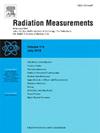Investigation of the effect of crystal dead layer on system performance in Single Photon Emission Computed Tomography: A Monte Carlo simulation study
IF 1.6
3区 物理与天体物理
Q2 NUCLEAR SCIENCE & TECHNOLOGY
引用次数: 0
Abstract
One of the factors affecting image quality in SPECT (Single Photon Emission Computed Tomography) applications is the dead layer that forms over time in the scintillation crystal. In this study, we aimed to investigate the effect of dead layers in the NaI(Tl) scintillation crystal used in SPECT on system performance. The GATE simulation code, which is based on the GEANT4 toolkit and is widely recognized for its application in nuclear imaging simulations, was employed for this investigation. In the first step, the standard SPECT model was simulated, and the SPECT performance parameters (sensitivity, spatial resolution, energy resolution, and contrast) for low 140 keV (for Tc), medium 167 keV (for 201Tl), and high 364 keV (for 131I) gamma energies have been analyzed. Then, various thicknesses of dead layers on the crystal were simulated, and the effect of the dead layer on the performance parameters was evaluated for the same energies. The results indicate a reduction in SPECT sensitivity of approximately 33.5%, 27.1%, and 21.7% for low, medium, and high energies, respectively, as the thickness of the crystal’s dead layer increases from 0.19 mm to 1.52 mm (equivalent to 2% to 16%). Small deteriorations in spatial resolution and energy resolution of the SPECT have been determined for 140 keV, 167 keV, and 364 keV gamma energies. The dead layers slightly influenced the contrast of SPECT. The results of this study show that the image quality assessment parameters of the SPECT system deteriorated as the thickness of the scintillation crystal’s dead layer increased.
单光子发射计算机断层扫描中晶体死区层对系统性能影响的蒙特卡罗模拟研究
在单光子发射计算机断层扫描(SPECT)应用中,影响图像质量的因素之一是随着时间的推移在闪烁晶体中形成的死层。在这项研究中,我们旨在研究用于SPECT的NaI(Tl)闪烁晶体中的死层对系统性能的影响。本研究采用基于GEANT4工具包的GATE仿真代码,该代码因其在核成像仿真中的应用而得到广泛认可。首先,模拟了标准SPECT模型,分析了低140 keV (99mTc)、中167 keV (201Tl)和高364 keV (131I)伽马能的SPECT性能参数(灵敏度、空间分辨率、能量分辨率和对比度)。然后,模拟了晶体上不同厚度的死区层,并在相同能量下评估了死区层对性能参数的影响。结果表明,当晶体死层厚度从0.19 mm增加到1.52 mm(相当于2%到16%)时,低、中、高能量的SPECT灵敏度分别降低了约33.5%、27.1%和21.7%。在140 keV, 167 keV和364 keV的伽马能量下,SPECT的空间分辨率和能量分辨率有很小的下降。死亡层对SPECT成像对比度影响较小。研究结果表明,随着闪烁晶体死区厚度的增加,SPECT系统的图像质量评价参数变差。
本文章由计算机程序翻译,如有差异,请以英文原文为准。
求助全文
约1分钟内获得全文
求助全文
来源期刊

Radiation Measurements
工程技术-核科学技术
CiteScore
4.10
自引率
20.00%
发文量
116
审稿时长
48 days
期刊介绍:
The journal seeks to publish papers that present advances in the following areas: spontaneous and stimulated luminescence (including scintillating materials, thermoluminescence, and optically stimulated luminescence); electron spin resonance of natural and synthetic materials; the physics, design and performance of radiation measurements (including computational modelling such as electronic transport simulations); the novel basic aspects of radiation measurement in medical physics. Studies of energy-transfer phenomena, track physics and microdosimetry are also of interest to the journal.
Applications relevant to the journal, particularly where they present novel detection techniques, novel analytical approaches or novel materials, include: personal dosimetry (including dosimetric quantities, active/electronic and passive monitoring techniques for photon, neutron and charged-particle exposures); environmental dosimetry (including methodological advances and predictive models related to radon, but generally excluding local survey results of radon where the main aim is to establish the radiation risk to populations); cosmic and high-energy radiation measurements (including dosimetry, space radiation effects, and single event upsets); dosimetry-based archaeological and Quaternary dating; dosimetry-based approaches to thermochronometry; accident and retrospective dosimetry (including activation detectors), and dosimetry and measurements related to medical applications.
 求助内容:
求助内容: 应助结果提醒方式:
应助结果提醒方式:


